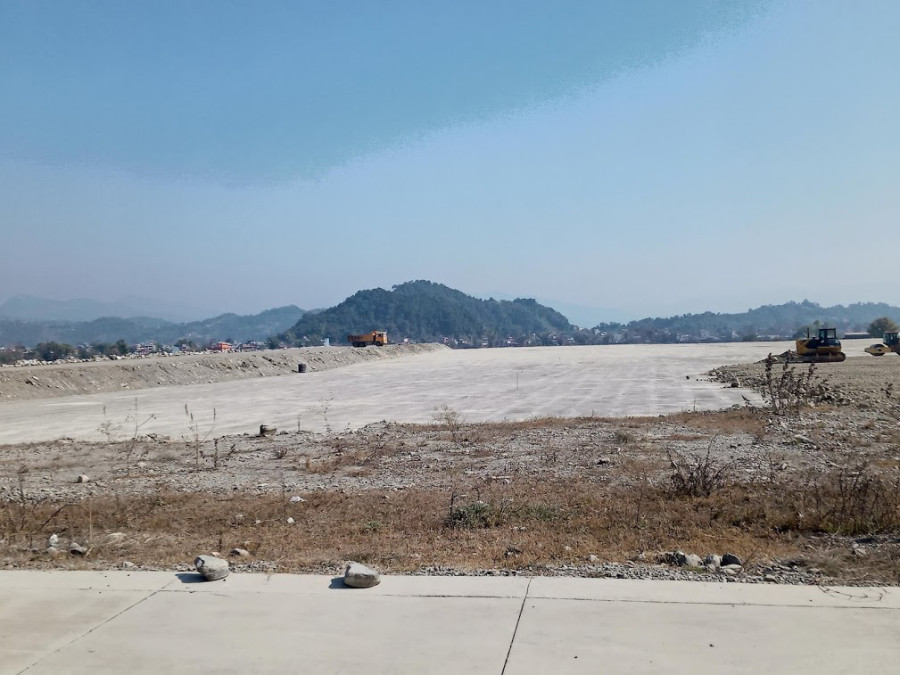Money
Pokhara airport project okayed to flatten hill near runway
Nepal's third international airport could be ready for operation by the beginning of 2022, officials said.
Sangam Prasain
The government has removed the last major obstacle to construction work on Pokhara International Airport, allowing the project to cut down trees and flatten a hill near the eastern end of the runway, thus clearing the way for the infrastructure to be possibly completed by year-end, officials said.
A cabinet meeting on March 4 gave the green signal to the Civil Aviation Authority of Nepal to clear the forest on Ritthepani hill, after delaying approval for several months. The proposal was tabled by the Ministry of Forests and Environment.
The decision will allow the country’s civil aviation body to lop off the top of two hills at Ritthepani by 40 and 12 metres respectively.
The runway of Pokhara International Airport is 45 metres wide and 2,500 metres long, and has an east-west orientation.
Located at Chinnedanda, 3 km east of the existing domestic airport, it will be Nepal's third international hub. The airport is the aerial gateway to the Annapurna region in the Himalayas, one of the country's most popular trekking destinations.
Pokhara International Airport has a one-way approach system, like at Kathmandu’s Tribhuvan International Airport. There is no possibility of expanding the airport as it sits in a narrow valley at an altitude of 800 metres above sea level.
“The cabinet has given its in-principle approval to chop down the trees. We are not sure if the government has inserted any conditions,” said Binesh Munankarmi, chief of the project. “We cannot say anything without seeing the cabinet’s decision.”
According to project officials, 600 trees, among them 80 large ones, need to be felled.
Munankarmi said that since the airport is a national pride project, they had sought permission to complete it on fast track.
“We are all ready to cut the trees and level the hilltop if no conditions have been attached. The task will take us at least six months,” he said.
“But if we have to fulfil conditions like preparing a new environment impact assessment report, we cannot say when the project will be completed.”
As per the current timetable, all tasks—including installation and tests of navigation and meteorological equipment, and certification of the airport—may be completed and the airport ready for operation by the beginning of 2022, officials said.
Rajan Pokhrel, director general of the Civil Aviation Authority of Nepal, said that the airport would have been ready on July 10, six months ahead of the completion deadline, if Covid-19 had not got in the way.
Pokhrel said that after the coronavirus pandemic struck, only one-third of the daily tasks could be done. “Due to the rapid progress made by the project before Covid-19, it may face a delay of only six months, which is still a remarkable achievement compared to the track record of other schemes in Nepal.”
Munankarmi said that 28 percent of the project remained to be completed—10 percent civil works and 18 percent installation works. “Most of the equipment has arrived at the airport site. We are hopeful of completing the project by the end of 2021, if the job of cutting the trees and flattening the hilltop goes smoothly,” said Munankarmi.
The selection of the construction site, detailed engineering work and master plan of Pokhara International Airport was initially prepared in 1971 by DIWI, a German consulting engineering firm. This work was performed by the former Department of Civil Aviation with an Asian Development Bank loan under the Airport Development Project in Nepal.
The government had acquired 3,106 ropanis of land for the airport in 1975.
A review of the new Pokhara Airport Master Plan prepared by DIWI was made by the Japan International Cooperation Agency (JICA) in 1988. JICA proposed to implement the project in two phases—the first from 1995-2000 at an estimated cost of $40 million.
The second phase from 2001-2010 was estimated to cost $45 million, following the completion of which the airport would be able to handle aircraft like the Boeing 757.
China CAMC Engineering won the construction contract for the project in May 2014, and work started in July 2017.
The government signed a $215.96 million soft loan agreement with China EXIM Bank in March 2016 to finance the airport built on engineering procurement and construction model.
Under this model, a single contractor takes responsibility for all components like design, engineering, construction and procurement. The contract binds the contractor to deliver the project at the stipulated time and predetermined price regardless of any possible cost overruns.
The runway will be able to handle medium-range commercial aircraft such as the Airbus A320, Boeing 737 and Boeing 757.
The airport will have a 1,200-metre-long and 23-metre-wide taxiway connecting the runway with the parking bays, hangars and terminals.
The main international terminal building has a capacity to handle 650 passengers per hour. The airport will have three parking bays for A320-type jets with aerobridge facility and five parking bays for ATR-type aircraft. There will be a separate terminal and parking bay for domestic flights.




 12.12°C Kathmandu
12.12°C Kathmandu













%20(1).jpg&w=300&height=200)
